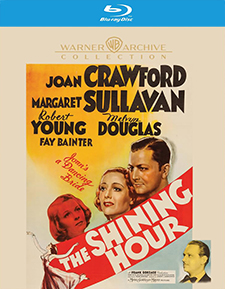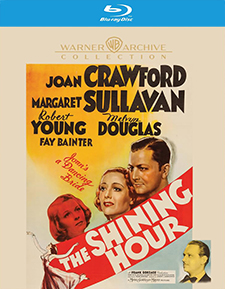Shining Hour, The (Blu-ray Review)

Director
Frank BorzageRelease Date(s)
1938 (June 25, 2024)Studio(s)
Metro-Goldwyn-Mayer (Warner Archive Collection)- Film/Program Grade: B-
- Video Grade: A
- Audio Grade: A
- Extras Grade: B
Review
The Shining Hour is a 1930s melodrama, based on a play by Keith Winter, that boasts a roster of stars and a sumptuous production. The film is an example of how MGM, in its heyday, assembled its vast resources to turn a soap opera into a major release.
According to liner notes on the Blu-ray, Joan Crawford saw the play on Broadway and lobbied to be in the film version. Crawford (The Women) plays Olivia Riley, a night club dancer at the top of her game but tired of her social circle, the endless parties, and New York’s fast pace. Olivia longs for a more serene life and finds it in Henry Linden (Melvyn Douglas, Ninotchka), a conservative millionaire who asks her to marry him. Though not really in love with him, she accepts his proposal.
They move to the Lindens’ Wisconsin estate and Olivia meets the rest of the family. Henry’s sister-in-law Judy (Margaret Sullavan, The Shop Around the Corner) is a cheerful, welcoming presence but her husband, David (Robert Young, The Enchanted Cottage), is suspicious of Olivia’s intentions. Henry’s older sister, Hannah (Fay Bainter, The Human Comedy), deems a showgirl unsuitable as a marriage partner for a Linden and takes no pains to disguise her hostility toward Olivia.
Gradually, David’s feelings toward Olivia change and he finds her a breath of fresh air among the staid Linden clan. He also finds himself drawn to her romantically, though Olivia does her best to discourage his feelings. Hannah sees what’s happening and does everything possible to drive Olivia away. Meanwhile, Judy’s slow to recognize that David sees in Olivia a vitality and excitement he was never able to see in her, and realizes that their marriage is one of complacency.
Top-billed Crawford is the focus of The Shining Hour. She gets to show off her dancing ability in a lengthy number partnered with Tony De Marco. Not the equal of Eleanor Powell or Ginger Rogers, she nonetheless handles the choreography well and looks elegant on the dance floor. The role of Olivia suits her—a woman from “the other side of the tracks” trying to prove herself worthy of an upper-class husband.
Sullavan, instantly likable as Judy, seems the most down-to-earth Linden in the household and immediately becomes Olivia’s friend and confidante. Judy sees good in everyone and later accepts, without vitriol, her husband’s fascination with another woman.
As Henry, Douglas comes off rather distant and preoccupied once his character returns to the family home. As David, Young lacks sufficient passion to convince us of the character’s growing infatuation with Olivia.
As Hannah, Bainter gets to share some biting exchanges with Crawford. Hannah refers to Olivia as a “disturbing influence” on the family without backing up those words. She simply relies on her gut feeling and acts on it. Hannah is scripted as a villainess with few redeeming qualities. Because of this, a complete about-face by Hannah late in the film becomes laughable.
The supporting cast includes Allyn Joslyn (The Shocking Miss Pilgrim) as one of Olivia’s many former beaus and the always-wonderful Hattie McDaniel (Since You Went Away) as Olivia’s personal maid, Belvedere.
Director Frank Borzage opens up the stage play with scenes in the night club where Olivia performs, an elegant after-party, an outdoor dance, and the extensive grounds of the Linden estate. The indoor scenes dominate, however, and Borzage stages them with lots of entrances, exits, movement, enhanced by astute editing. There’s never a sense of claustrophobia. The film proceeds fairly well until it falls apart in its third act with a climax that brings to mind the denouement of Rebecca, made two years later. The “happy ending” is contrived, unlikely, and disappointing. The Shining Hour is a minor picture but at least parades a bunch of MGM stars across the screen during Hollywood’s Golden Age.
The Shining Hour was shot by director of photography George Folsey on 35 mm black & white film with spherical lenses, finished photochemically, and presented in the Academy aspect ratio of 1.37:1. The Blu-ray print was sourced from a 4K scan of the best-available preservation elements. Quality is excellent, with a pleasing silvery tone to the images. Detail is sharp and well delineated in dress patterns, nightclub decor, the exterior of the large Linden house, trees and shrubbery, and lights strung for an outdoor party. The women are photographed flatteringly, with close-ups especially reflecting care. This was a trademark of MGM—making its leading ladies look as beautiful as possible.
The soundtrack is English 2.0 DTS-HD Master Audio. English SDH subtitles are available. Dialogue is clear and distinct. Joan Crawford’s dance number orchestration strives for smooth elegance. The only major sound effects are a raging, crackling fire and debris crashing down. Franz Waxman’s score is merely serviceable and doesn’t come up to the quality of his scores for Bride of Frankenstein or A Place in the Sun.
Bonus materials on the Blu-ray release from the Warner Archive Collection include the following:
- Good News of 1939 (23:00)
- Love and Curses (8:27)
- Porky’s Five and Ten (7:05)
- The Sneezing Weasel (6:43)
- Original Theatrical Trailer (2:58)
Good News of 1939 – In this radio program, sponsored by Maxwell House Coffee, a narrator tells the story of The Shining Hour along with scenes from the movie.
Love and Curses – In this 1938 Technicolor Merrie Melodies cartoon directed by Ben Hardaway and Cal Dalton, an aging hero is looking through a photo album and remembering the Gay 90s, particularly a picnic interrupted by villainous Roger St. Clair, who tries to tempt Emily to the big city and away from Harold. When that fails, Roger takes her by force. Six months later, Harold is still searching for Emily, who is forced to sing on stage in Roger’s bar, accompanied by a barbershop quartet on All Is Not Gold That Glitters. Harold passes by and hears her. There’s a confrontation, Harold is knocked out, and Roger ties Emily to the railroad tracks. Harold rescues her, more commotion follows, and eventually Harold prevails. Back to the present, Harold wonders what happened to Roger, who appears and takes back Emily. Harold pursues Roger, but not before singing a chorus of Poor Old Joe.
Porky’s Five and Ten – Porky Pig sets sail for the Boola-Boola islands in the South Seas with a ship full of general merchandise and plans to open a 5 & 10 cent store. But a swordfish cuts a hole in the ship and Porky’s goods fall into the ocean, where the fish make creative uses of them, ultimately opening a Hollywood nightclub complete with fish impersonating various stars, including Greta Garbo, FDR, Mae West, Jack Dempsey, and Laurel & Hardy. Porky is saved when a waterspout comes along, re-stocking his ship. This 1938 black & white Looney Tunes was directed by Robert Clampett.
The Sneezing Weasel – In this 1938 Technicolor Merrie Melodies cartoon directed by Tex Avery, while a mother hen is away, a group of young chicks must defend themselves from Willy the Weasel, disguised as a doctor, who’s planning to have them for dinner. One of the chicks, Wilbur, sneezes and blows off the weasel’s disguise. The chicks fight the weasel using military techniques until they’re too much for the predator, and he leaves.
The Shining Hour benefits from a first-rate cast but can’t rise above routine melodrama and eventually loses its way, resulting in not only a disappointing ending, but a silly one. Crawford comes off best, typecast in a role as an ambitious show biz headliner looking to better herself through marriage and trying her best to fit into a blue-blooded family. If soap opera could be given a patina of grandeur, MGM sure knew how to do it.
- Dennis Seuling

